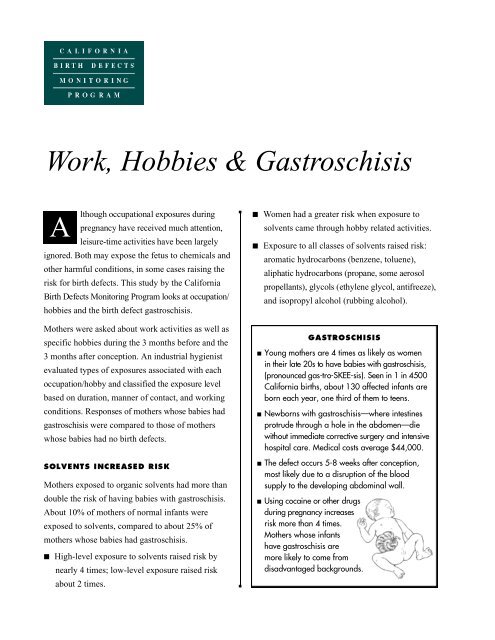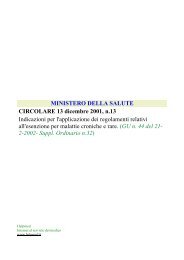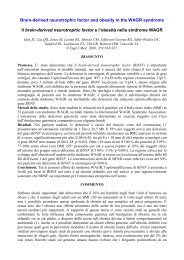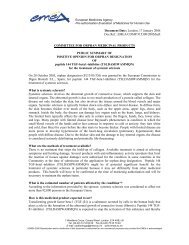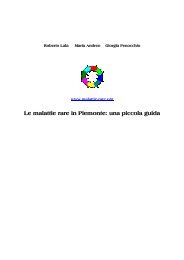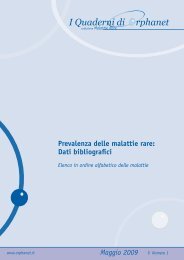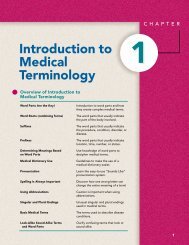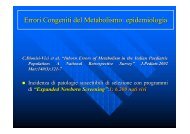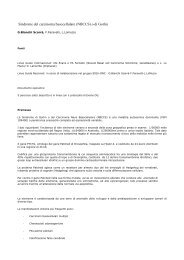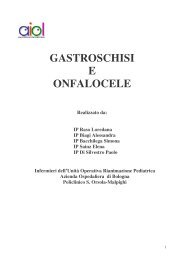Work, Hobbies & Gastroschisis A - Malattie metaboliche.it
Work, Hobbies & Gastroschisis A - Malattie metaboliche.it
Work, Hobbies & Gastroschisis A - Malattie metaboliche.it
You also want an ePaper? Increase the reach of your titles
YUMPU automatically turns print PDFs into web optimized ePapers that Google loves.
<strong>Work</strong>, <strong>Hobbies</strong> & <strong>Gastroschisis</strong><br />
A<br />
lthough occupational exposures during<br />
pregnancy have received much attention,<br />
leisure-time activ<strong>it</strong>ies have been larg e l y<br />
ignored. Both may expose the fetus to chemicals and<br />
other harmful cond<strong>it</strong>ions, in some cases raising the<br />
risk for birth defects. This study by the California<br />
Birth Defects Mon<strong>it</strong>oring Program looks at occupation/<br />
hobbies and the birth defect gastroschisis.<br />
Mothers were asked about work activ<strong>it</strong>ies as well as<br />
specific hobbies during the 3 months before and the<br />
3 months after conception. An industrial hygienist<br />
evaluated types of exposures associated w<strong>it</strong>h each<br />
occupation/hobby and classified the exposure level<br />
based on duration, manner of contact, and working<br />
cond<strong>it</strong>ions. Responses of mothers whose babies had<br />
g a s t r o s c h i s i swere compared to those of mothers<br />
whose babies had no birth defects.<br />
SOLVENTS INCREASED RISK<br />
Mothers exposed to organic solvents had more than<br />
double the risk of having babies w<strong>it</strong>h gastroschisis.<br />
About 10% of mothers of normal infants were<br />
exposed to solvents, compared to about 25% of<br />
mothers whose babies had gastroschisis.<br />
■ High-level exposure to solvents raised risk by<br />
nearly 4 times; low-level exposure raised risk<br />
about 2 times.<br />
■ Women had a greater risk when exposure to<br />
solvents came through hobby related activ<strong>it</strong>ies.<br />
■ Exposure to all classes of solvents raised risk:<br />
aromatic hydrocarbons (benzene, toluene),<br />
aliphatic hydrocarbons (propane, some aerosol<br />
p r o p e l l a n t s ), glycols (ethylene glycol, antifreeze),<br />
and isopropyl alcohol (rubbing alcohol).<br />
G A S T R O S C H I S I S<br />
■ Young mothers are 4 times as likely as women<br />
in their late 20s to have babies w<strong>it</strong>h gastroschisis,<br />
(pronounced gas-tro-SKEE-sis). Seen in 1 in 4500<br />
California births, about 130 affected infants are<br />
born each year, one third of them to teens.<br />
■ Newborns w<strong>it</strong>h gastroschisis—where intestines<br />
protrude through a hole in the abdomen—die<br />
w<strong>it</strong>hout immediate corrective surgery and intensive<br />
hosp<strong>it</strong>al care. Medical costs average $44,000.<br />
■ The defect occurs 5-8 weeks after conception,<br />
most likely due to a disruption of the blood<br />
supply to the developing abdominal wall.<br />
■ Using cocaine or other drugs<br />
during pregnancy increases<br />
risk more than 4 times.<br />
Mothers whose infants<br />
have gastroschisis are<br />
more likely to come from<br />
disadvantaged backgrounds.
■ Solvents are found in a wide range of products,<br />
such as gasoline, motor oil, paint thinner, polyurethane,<br />
spray paint, aerosol sprays, nail polish<br />
remover, and many cleaning products. The study<br />
looked at exposures to solvents in general—<strong>it</strong><br />
did not focus on possible risks from any of these<br />
specific exposures.<br />
■ Women who engaged in hobbies w<strong>it</strong>h solvent<br />
exposure—automechanics, furn<strong>it</strong>ure stripping,<br />
and painting—had a risk 2 to 4 times higher.<br />
such as doing your nails, is probably OK,” says<br />
researcher Claudine Torfs. “But try to avoid<br />
frequent or intense exposures.”<br />
POPULATION-BASED STUDY DESIGN<br />
All cases were identified through ongoing surveillance<br />
by the California Birth Defects Mon<strong>it</strong>oring<br />
Program registry, a population-based, a c t i v e l y<br />
a s c e r t a i n e ddatabase on children w<strong>it</strong>h birth defects.<br />
Specific study elements follow:<br />
■ Secondhand exposure to solvents—through the<br />
activ<strong>it</strong>ies of another person in the household—<br />
did not increase the risk for gastroschisis.<br />
COLORING AGENTS ALSO RAISED RISK<br />
Mothers exposed to colorants—pigments, metallic<br />
and organic dyes—doubled their risk. Exposure was<br />
seen in 16% of mothers of normal infants and 29%<br />
of women whose babies had gastroschisis.<br />
■ Colored wall or furn<strong>it</strong>ure paints, fabric dyes/paint,<br />
permanent hair dye, nail polish, and corroded<br />
metal all contain colorants.<br />
■ Exposure can come from occupations/hobbies<br />
such as cosmetology, painting, fabric dyeing,<br />
and automechanics (handling corroded parts).<br />
CONSIDER ALL SOURCES OF EXPOSURE<br />
■<br />
■<br />
■<br />
Participants: 110 mothers of infants w<strong>it</strong>h<br />
gastroschisis and 220 mothers of the same ages<br />
whose infants did not have birth defects. All<br />
babies were born between 1988-1990. Only<br />
Wh<strong>it</strong>e or Latina women were included because<br />
there were few cases in other racial/ethnic<br />
g r o u p s .<br />
Interview: Conducted in the mother’s home by<br />
a trained interviewer, in English or Spanish,<br />
3-6 months after the baby’s birth. The 2.5-hour<br />
structured questionnaire asked about the mother’s<br />
pregnancy, diet, health, drug use, occupation,<br />
hobbies, and demographics as well as about the<br />
baby’s father and grandparents.<br />
Diagnostic information: Abstracted from<br />
hosp<strong>it</strong>al medical records and reviewed by a<br />
geneticist to ensure correct classification.<br />
Expectant mothers should use caution as they<br />
consider possible exposures from their activ<strong>it</strong>ies<br />
at home and in the workplace. Even seemingly<br />
harmless hobbies may raise the risk for birth defects.<br />
Further studies are needed to delineate risks<br />
associated w<strong>it</strong>h specific exposures. “Until then,<br />
occasional low exposure to solvents or colorants,<br />
REFERENCE: Torfs CP, Katz EA, Bateson TF, Lam PK,<br />
Curry CJR. Maternal medications and environmental<br />
exposures as risk factors for gastroschisis. T e r a t o l o g y<br />
1 9 9 6 ; 5 4 : 8 4 - 9 2 .<br />
The California Birth Defects Mon<strong>it</strong>oring Program—<br />
a public health program devoted to finding causes of birth defects—<br />
is funded through the California Department of Health Services<br />
and jointly operated w<strong>it</strong>h the March of Dimes Birth Defects Foundation.<br />
April 1999


